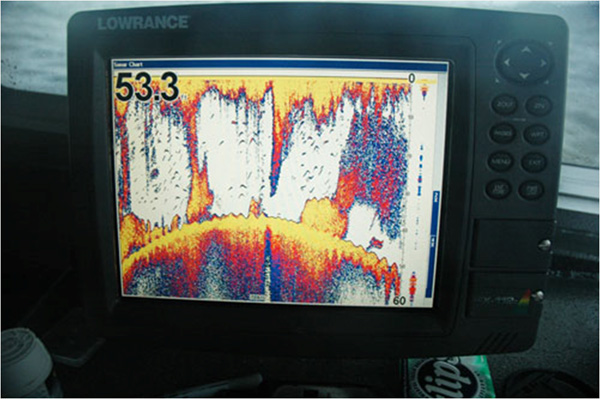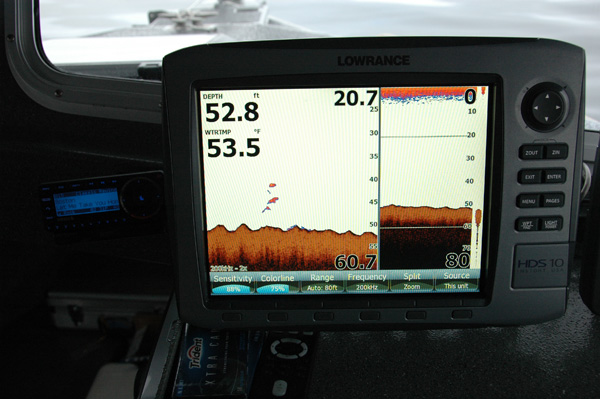The Electronics Advantage 6
I can still remember dad and I trying to read the graph on our old Sitex paper sonar as we toodled around the Puget Sound in search of salmon, bottomfish, shrimp, crab, and scuba diving spots. Other than seeing what the bottom looked like and possibly a hapless bait ball once in a while, the graph was all but useless. My how these machines have changed!
Nowadays the dash on my Alaskan charter boat is consumed by two 10 inch Lowrance units that do everything but cook lunch and wash the boat. My "old" unit is a Lowrance 113 that displays my GPS and mapping data and when the fog rolls in I split the screen to show both radar and GPS. I say "old" because the 113 was only a year old when the new HDS hit the market. Next spring we'll be installing the new Lowrance broadband sonar onto the charter boat that will allow both the GPS data and radar to be overlayed, and it will also give me the ability to ping VHF's that share the same Digital Selective Calling network. Once the DSC system is in place the boats in our fleet will only need to key their mic's and their position will show up immediately on the GPS. VHF commications will cease to be like this, "Well, we're across the street at that "one" spot we talked about", or "you know, that spot we caught the kings at yesterday."
The latest position-tracking technology may allow us to find a fishing spot, but once on location the real electronics advantage is in the sonar unit. A brand new Lowrance HDS broadband unit resides next to my 113 and all it displays is sonar…a full screen of nothing but sonar, sonar, and more sonar. The new HDS is more like an office computer than one would think, with built in broadband sonar, GPS, radar, Sirius satellite radio and weather, SD memory card slots for uploading and downloading data, and layer upon layer of settings for each and much easier to use than the home computer.
With fast trolling, slow trolling, surface clarity, noise rejection, and numerous other settings the sonar can be set to pick up a grain of sand passing under the boat and adjustments can be made on the fly as conditions change. Bottom-hugging salmon, rockfish suspended over structure, baitfish, and even halibut don't slide by un-noticed. When we're fishing amongst a bunch of boats I can quickly fine tune the sonar unit to reject noise from nearby transducers and as depth and conditions change the sensitivity can be quickly changed to paint everything that passes under the transducer.
The sensitivity on my sonar is usually set at around 92%, but for one reason or another I'll sometimes need to drop the sensitivity down into the high 80's or perhaps turn it up. On a near-daily basis I will run the sensitivity up or down as large masses of bait or marks appear on the screen that could be salmon. Adjusting the sensitivity up slightly will sometimes paint fish with a much clearer hairline arch and will give color to the body that wasn't there before. This "practice" with my sonar, so to speak, has gotten me comfortable with identifying marks on the screen and knowing for certain what they are.
What's Going On Down There?
Here's a few pictures I've taken of my sonar the last couple of years that might further explain what I'm talking about:
Here's a no-brainer for ya! The screen contains multiple schools of feed with countless silvers mixed in gorging themselves on the bait. The mark on the bottom right of the screen is two kings which promptly jumped on two cut plug herring that we dropped on mooching gear, making for an exciting double-header.

This bait ball was 100 feet thick at it's broadest point and around 100 yards long. On the bottom left corner you can make out the easy to use sensitivity button on the bottom of the Lowrance HDS unit. Adjustments can be made very quickly with this easy to use button on the front of the machine.

This mark was very subtle until I turned the sensitivity up to 92% on the HDS unit. This is actually two 20 pound kings swimming very close to one another. We quickly dropped cut plug herring to these fish, landing one and losing the other. There is also a school of bait just noticable on the lower left of the screen.

The bottom zoom on the HDS was picking up schools of silvers in this relatively shallow water. This school resulted in a quadruple hookup on silvers between 10 and 14 pounds. After we landed these fish I quickly turned the sensitivity to 95% and began picking up fish on the full screen, as well. And yes, silvers respond very well to "Boston", seen on the Sirius satellite reciever. Sorry, fishing was just too fast to get any more pictures!

Capt. Rob Endsley


Yeah, you are right, I agree with you.
Haaa...we had a flasher before the paper graph and it too was a p.o.s.!
Robbo, you rich guys had it all. We had the old flasher round display kind and the light got so dim we had to put a hood over it to even read it.
Hey, Cliff! Is this the same Cliff from those hilarious You Tube vids? We need to talk about your vids. 95% of the time corroded connections and bad voltage are the culprits when electronics go gunny-bag. Even just a little bit of corrosion on the connector will cause the sonar and GPS some grief. Not sure what's going on with your Lowrance gear, but the first place I'd look is the wiring and the connectors. If you've already gone thru all this and it's the actual gear itself that's malfunctioning send me an email at "rendsley@earthlink.net" and I'll put you in contact with the right person at Lowrance. You can also call me at (360) 961-2116. Happy to help! Rob Endsley
The technology for tracking fish is great but I have to say that our Lowrance is about as useless as it gets. About all it really seems good for is telling us how far down our downrigger balls are. Most of the time the GPS doesn't even work.
Great post!! Once you know what's on the screen, don't forget to work your gear to that depth.